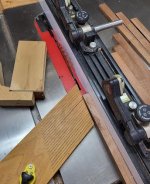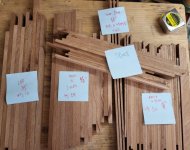I can. So to explain it better, I set the fence to the width I want the final width to be plus at least 100mm. Then I get board roughly same size as the table, and run it along the fence to create a zero clearance slot. Then I get another scrap around 100mm wide, stick a sample of the exact width strip I want on the inside of the fence and run the narrow MDF through leaving a little bit at the end which I trim at 90degree with a saw.
I then have the same setup as the video, except I also have a board under it all creating a zero clearance fit.
When I machine, I tend to do a very large amount of any one process at a time, so the slight extra time doing a base board first really saves me loads of time overall, and I get a perfect safe finish so can really speed them through.
Hope that all makes sense?
I've sold my cabinet saw since but I'm now looking at the Laguna FS2, in which case I'll then make a sled with an integrated slotted adjustable fence out of perspex.


